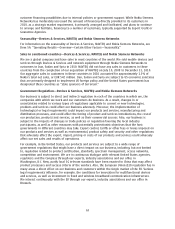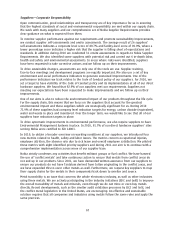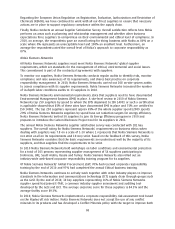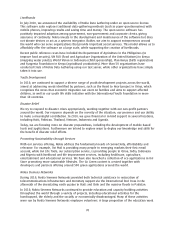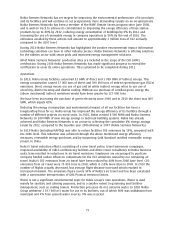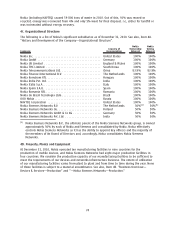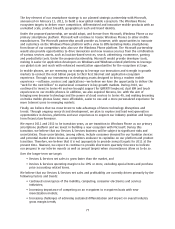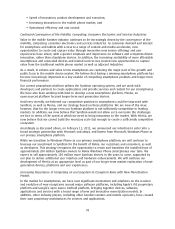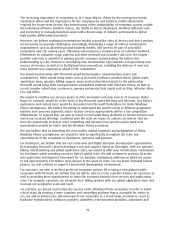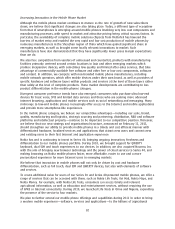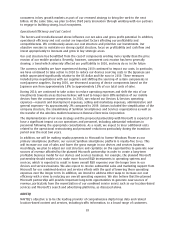Nokia 2010 Annual Report Download - page 74
Download and view the complete annual report
Please find page 74 of the 2010 Nokia annual report below. You can navigate through the pages in the report by either clicking on the pages listed below, or by using the keyword search tool below to find specific information within the annual report.Nokia Siemens Networks has set targets for improving the environmental performance of its products
and its facilities and will continue to set progressively more demanding targets on an ongoing basis.
Nokia Siemens Networks has been a member of the WWF Climate Savers program since June 2008,
and is well on track to achieve its commitment to improving the energy efficiency of base station
products by up to 40% by 2012, reducing energy consumption of buildings by 6% by 2012 and
increasing the use of renewable energy in company operations to 50% by the end of 2010. The
emissions avoided by these actions will amount to approximately 2 million tons of CO2 annually
compared to the 2007 level.
During 2010 Nokia Siemens Networks has highlighted the positive environmental impact information
technology solutions can have in other industry sectors. Nokia Siemens Networks is offering solutions
for the utilities sector with smart grids and improved energy management solutions.
All of Nokia Siemens Networks’ production sites are included in the scope of the ISO 14001
certification. During 2010 Nokia Siemens Networks has made significant progress to extend the
certification to cover its entire operations. This is planned to be completed during 2011.
Operations
In 2010, Nokia Group facilities consumed 91 GWh of direct and 1 099 GWh of indirect energy. This
energy consumption caused 17 000 tons of direct and 396 000 tons of indirect greenhouse gas (CO2e)
emissions. Direct energy means our use of gas and oil while indirect energy refers to our use of
electricity, district heating and district cooling. Without our purchase of certified green energy the
(above mentioned) indirect emissions would have been greater by 127 000 tons.
We have been increasing the purchase of green electricity since 2006 and in 2010 the share was 409
GWh, which equals 42%.
Reducing the energy consumption and environmental impact of all our facilities has been a
longstanding focus for us. Nokia Group has improved the energy efficiency of its facilities through a
number of different projects in recent years. In 2010, Nokia created 8 500 MWh and Nokia Siemens
Networks 10 100 MWh of new energy savings in technical building systems. Nokia has already
achieved and Nokia Siemens Networks is on course to achieving the cumulative 6% energy savings
target by 2012, compared to the baseline year 2006 (Nokia) or 2007 (Nokia Siemens Networks).
In 2010 Nokia (including NAVTEQ) was able to reduce facilities CO2 emissions by 19%, compared with
the 2006 level. This reduction was achieved through the above mentioned energy efficiency
measures, renewable energy purchases and by supporting Gold Standard certified renewable energy
project in China.
Nokia’s travel reduction efforts, consisting of a new travel policy, travel awareness campaigns,
improved availability of video conferencing facilities and direct travel consultancy to Nokia business
units, have resulted in reductions in air travel emissions. Employees are encouraged to purchase
company funded carbon offsets to compensate for the CO2 emissions caused by our remaining air
travel. Nokia’s CO2 emissions from air travel have been reduced by 40% from 2008 base level. CO2
emissions from air travel were 75 893 tons in 2010, which is 2.8% more than in 2009. In 2010 the
number of flights actually decreased, but average flight distance increased which resulted in
increased emissions. The emissions figure covers 95% of Nokia’s air travel and has been calculated
with a conservative interpretation of GHG Protocol emission factors.
Water is not a significant environmental topic for Nokia Group’s own operations. Water is used
mainly for sanitary and catering purposes, and to a smaller extent in gardening and facilities
management, such as cooling towers. Production processes do not consume water. In 2010 Nokia
Group withdrew 2 197 000 m3 water for use in its facilities, out of which 96% was withdrawn from
municipal and 4% from ground water sources. 9% was recycled.
73


